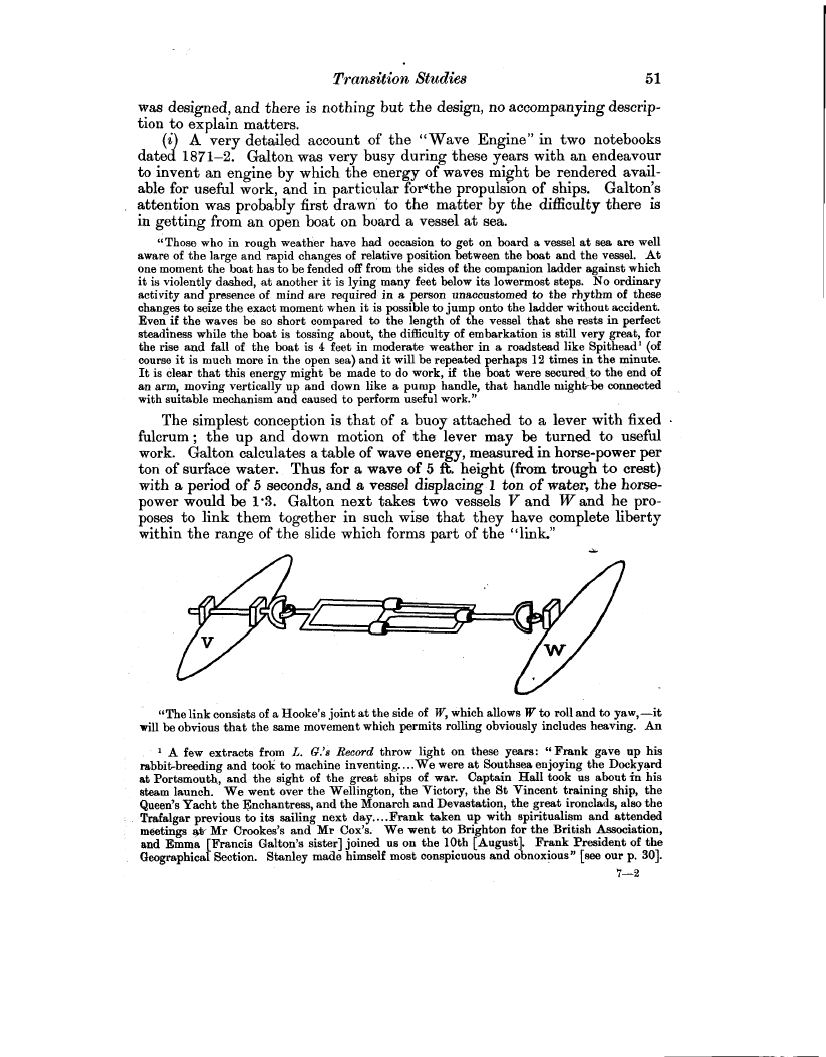Transition Studies 51
was designed, and there is nothing but the design, no accompanying description to explain matters.
(i) A very detailed account of the "Wave Engine" in two notebooks dated 1871-2. Galton was very busy during these years with an endeavour to invent an engine by which the energy of waves might be rendered available for useful work, and in particular for~the propulsion of ships. Galton's attention was probably first drawn to the matter by the difficulty there is in getting from an open boat on board a vessel at sea.
"Those who in rough weather have had occasion to get on board a vessel at sea are well aware of the large and rapid changes of relative position between the boat and the vessel. At one moment the boat has to be fended off from the sides of the companion ladder against which
it is violently dashed, at another it is lying many feet below its lowermost steps. No ordinary activity and presence of mind are required in a person unaccustomed to the rhythm of these changes to seize the exact moment when it is possible to jump onto the ladder without accident. Even if the waves be so short compared to the length of the vessel that she rests in perfect steadiness while the boat is tossing about, the difficulty of embarkation is still very great, for the rise and fall of the boat is 4 feet in moderate weather in a roadstead like Spithead' (of course it is much more in the open sea) and it will be repeated perhaps 12 times in the minute. It is clear that this energy might be made to do work, if the boat were secured_ to the end of an arm, moving vertically up and down like a pump handle, that handle might-be connected
with suitable mechanism and caused to perform useful work."
The simplest conception is that of a buoy attached to a lever with fixed fulcrum ; the up and down motion of the lever may be turned to useful work. Galton calculates a table of wave energy, measured in horse-power per ton of surface water. Thus for a wave of 5 ft. height (from trough to crest) with a period of 5 seconds, and a vessel displacing l ton of water, the horsepower would be 1.3. Galton next takes two vessels V and Wand he proposes to link them together in such wise that they have complete liberty within the range of the slide which forms part of the "link."
"The link consists of a Hooke's joint at the side of W, which allows W to roll and to yaw,-it will be obvious that the same movement which permits rolling obviously includes heaving. An
1 A few extracts from L. G.'s Record throw light on these years: " Frank gave up his rabbit-breeding and took to machine inventing. ... We were at Southsea enjoying the Dockyard at Portsmouth, and the sight of the great ships of war. Captain Hall took us about in his steam launch. We went over the Wellington, the Victory, the St Vincent training ship, the Queen's Yacht the Enchantress, and the Monarch and Devastation, the great ironclads, also the Trafalgar previous to its sailing next day.... Frank taken up with spiritualism and attended meetings atr Mr Crookes's and Mr Cox's. We went to Brighton for the British Association, and Emma [Francis Galton's sister] joined us on the 10th [August]. Frank President of the Geographical Section. Stanley made himself most conspicuous and obnoxious" [see our p. 30].
7-2

